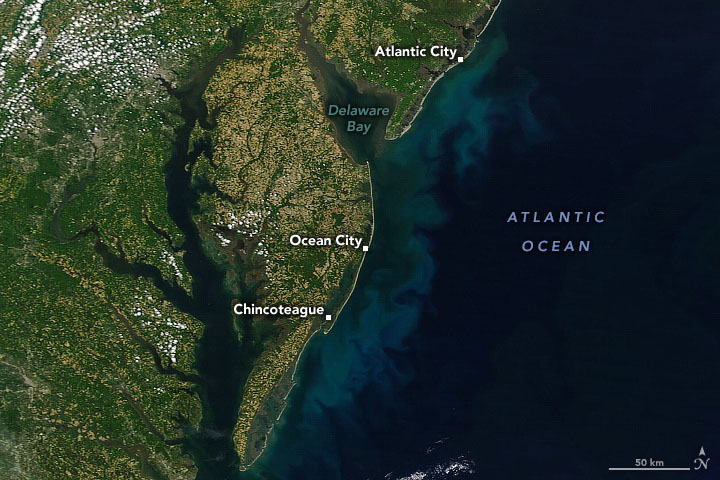The Blooming Mid-Atlantic
May 19, 2021 / NASA – Earth Observatory / Story by NASA Earth Observatory
Given adequate sunlight and nutrients, phytoplankton populations can multiply into blooms large enough to be visible from space. That was the case on May 18, 2021, when the Moderate Resolution Imaging Spectroradiometer (MODIS) on NASA’s Terra satellite acquired this natural-color image of a phytoplankton bloom along the coast of New Jersey, Delaware, Maryland, and Virginia.
Some of the nutrients that fueled the bloom likely came from runoff from the Delaware River watershed. Farms, wastewater treatment plants, urban and suburban areas, and other sources all contribute nutrients that can encourage blooms.
“It’s always a challenge to be definitive about what MODIS is picking up in the coastal zone. There are a lot of things that provide color to the coastal ocean, including sediment, chromoporhic dissolved organic matter (CDOM), and phytoplankton,” explained Bob Chant, an oceanographer at Rutgers University. “But in this case, it sure looks like we are seeing the Delaware River plume, which contains all three of those elements of color, plus enough nutrients to fuel and sustain large blooms.”
The Delaware River plume may have also gotten some help from below the waterline. “Winds from the south often drive surface waters offshore due to Earth’s rotation and Ekman Transport,” said Chant. “This often causes nutrient-rich water to well up toward the surface in the summer.”
The tides likely also contributed to the appearance of this bloom. “The image occurred during a neap tide, a period with more moderate tides when the bay discharges more fresh water and the plume becomes larger,” said Chant.
On a global scale, phytoplankton are responsible for nearly half of Earth’s primary production, turning carbon dioxide, sunlight, and nutrients into the food that ultimately fuels almost everything in the sea, from finfish to shellfish and from zooplankton to whales.
NASA Earth Observatory image by Joshua Stevens, using MODIS data from NASA EOSDIS LANCE and GIBS/Worldview. Story by Adam Voiland.
